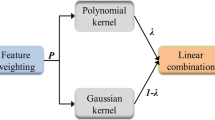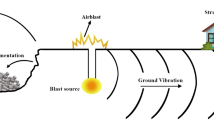Abstract
One of the main factors in the effective application of a tunnel boring machine (TBM) is the ability to accurately estimate the machine performance in order to determine the project costs and schedule. Predicting the TBM performance is a nonlinear and multivariable complex problem. The aim of this study is to predict the performance of TBM using the hybrid of support vector regression (SVR) and the differential evolution algorithm (DE), artificial bee colony algorithm (ABC), and gravitational search algorithm (GSA). The DE, ABC and GSA are combined with the SVR for determining the optimal value of its user defined parameters. The optimization implementation by the DE, ABC and GSA significantly improves the generalization ability of the SVR. The uniaxial compressive strength (UCS), average distance between planes of weakness (DPW), the angle between tunnel axis and the planes of weakness (α), and intact rock brittleness (BI) were considered as the input parameters, while the rate of penetration was the output parameter. The prediction models were applied to the available data given in the literature, and their performance was assessed based on statistical criteria. The results clearly show the superiority of DE when integrated with SVR for optimizing values of its parameters. In addition, the suggested model was compared with the methods previously presented for predicting the TBM penetration rate. The comparative results revealed that the hybrid of DE and SVR yields a robust model which outperforms other models in terms of the higher correlation coefficient and lower mean squared error.





Similar content being viewed by others
References
Acaroglu O, Ozdemir L, Asbury B (2008) A fuzzy logic model to predict specific energy requirement for TBM performance prediction. Tunn Undergr Sp Technol 23:600–608
Aeberli U, Wanner H (1978) On the influence of geologic conditions at the application of tunnel boring machines. In: 3rd international conference international association of engineering geology, Madrid vol 2, pp 7–14
Bamford W (1984) Rock test indices are being successfully correlated with tunnel boring machine performance. In: Proceedings of the 5th Australian tunneling conference, Melbourne, Australian, pp 9–22
Barton NR (2000) TBM tunnelling in jointed and faulted rock. CRC Press, Balkema, Rotterdam
Benardos A, Kaliampakos D (2004a) A methodology for assessing geotechnical hazards for TBM tunnelling—illustrated by the Athens Metro, Greece. Int J Rock Mech Min Sci 41:987–999
Benardos A, Kaliampakos D (2004b) Modelling TBM performance with artificial neural networks. Tunn Undergr Sp Technol 19:597–605
Blindheim O (1979) Boreability predictions for tunneling. Ph.D. Thesis
Bruland A (1998) Hard rock tunnel boring, Ph.D. Thesis. Ph.D. Thesis, Norwegian University of Science and Technology
Cassinelli F, Cina S, Innaurato N, Mancini R, Sampaolo A (1982) Power consumption and metal wear in tunnel-boring machines: analysis of tunnel-boring operation in hard rock. Tunneling 82:73–81
Dollinger G, Handewith H, Breeds C (1998) Use of the punch test for estimating TBM performance. Tunn Undergr Sp Technol 13:403–408
Farmer I, Glossop N (1980) Mechanics of disc cutter penetration. Tunn Tunn 12:22–25
Farrokh E, Rostami J, Laughton C (2012) Study of various models for estimation of penetration rate of hard rock TBMs. Tunn Undergr Sp Technol 30:110–123
Gehring K (2009) The influence of TBM design and machine features on performance and tool wear in rock. Der Einfluss von TBM-Konstruktion und Maschineneigenschaften auf Leistung und Werkzeugverbrauch in Gestein Geomech Tunnel 2:140–155
Ghasemi E, Yagiz S, Ataei M (2014) Predicting penetration rate of hard rock tunnel boring machine using fuzzy logic. Bull Eng Geol Environ 73:23–35
Graham P (1976) Rock exploration for machine manufacturers. In: Bieniawski ZT (ed) Exploration for rock engineering. Balkema, Rotterdam, pp 173–180
Grima MA, Bruines P, Verhoef P (2000) Modeling tunnel boring machine performance by neuro-fuzzy methods. Tunn Undergr Sp Technol 15:259–269
Hamidi JK, Shahriar K, Rezai B, Rostami J (2010) Performance prediction of hard rock TBM using Rock Mass Rating (RMR) system. Tunn Undergr Sp Technol 25:333–345
Hassanpour J, Rostami J, Khamehchiyan M, Bruland A (2009) Developing new equations for TBM performance prediction in carbonate-argillaceous rocks: a case history of Nowsood water conveyance tunnel. GeoMech GeoEng: Int J 4:287–297
Hassanpour J, Rostami J, Zhao J (2011) A new hard rock TBM performance prediction model for project planning. Tunn Undergr Sp Technol 26:595–603
Kang F, Li J, Xu Q (2009) Structural inverse analysis by hybrid simplex artificial bee colony algorithms. Comput Struct 87:861–870
Karaboga D, Basturk B (2008) On the performance of artificial bee colony (ABC) algorithm. Appl Soft Comput 8:687–697
Li C, Zhou J (2011) Parameters identification of hydraulic turbine governing system using improved gravitational search algorithm. Energy Convers Manag 52:374–381
Mahdevari S, Shahriar K, Yagiz S, Shirazi MA (2014) A support vector regression model for predicting tunnel boring machine penetration rates. Int J Rock Mech Min Sci 72:214–229
Moradi MR, Farsangi MAE (2014) Application of the risk matrix method for geotechnical risk analysis and prediction of the advance rate in rock TBM tunneling. Rock Mech Rock Eng 47:1951–1960
Rashedi E, Nezamabadi-Pour H, Saryazdi S, Farsangi MM (2007) Allocation of static var compensator using gravitational search algorithm. world 1:10
Rashedi E, Nezamabadi-Pour H, Saryazdi S (2009) GSA: a gravitational search algorithm. Inf Sci 179:2232–2248
Rashedi E, Nezamabadi-Pour H, Saryazdi S (2011) Filter modeling using gravitational search algorithm. Eng Appl Artif Intell 24:117–122
Ribacchi R, Fazio AL (2005) Influence of rock mass parameters on the performance of a TBM in a gneissic formation (Varzo Tunnel). Rock Mech Rock Eng 38:105–127
Rostami J (1997) Development of a force estimation model for rock fragmentation with disc cutters through theoretical and physical measurement of crushed zone pressure. Ph.D Dissertation, Colorado School of Mines, Golden, Colorado
Rostami J, Ozdemir L (1993) A new model for performance prediction of hard rock TBMs. In: Proceedings of the rapid excavation and tunneling conference, Boston. Society for mining, metallogy and exploration, INC, p 793
Salimia A, Moormanna C, Singhb T, Jainc P (2015) TBM performance prediction in rock tunneling using various artificial intelligence algorithms. In: 11th Iranian and 2nd regional tunnelling conference Iran
Sanio H (1985) Prediction of the performance of disc cutters in anisotropic rock. Int J Rock Mech Min Sci 22:153–161
Sapigni M, Berti M, Bethaz E, Busillo A, Cardone G (2002) TBM performance estimation using rock mass classifications. Int J Rock Mech Min Sci 39:771–788
Sarafrazi S, Nezamabadi-pour H (2013) Facing the classification of binary problems with a GSA–SVM hybrid system. Math Comput Model 57:270–278
Singh A (2009) An artificial bee colony algorithm for the leaf-constrained minimum spanning tree problem. Appl Soft Comput 9:625–631
Storn R, Price K (1995) Differential evolution-a simple and efficient adaptive scheme for global optimization over continuous spaces vol 3. ICSI Berkeley
Tarkoy PJ (1973) Predicting tunnel boring machine (TBM) penetration rates and cutter costs in selected rock types. In: Ninth Canadian rock mechanics symposium, Montreal
Torabi S, Shirazi H, Hajali H, Monjezi M (2013) Study of the influence of geotechnical parameters on the TBM performance in Tehran-Shomal highway project using ANN and SPSS. Arab J Geosci 6:1215–1227
Vapnik V (1999) The nature of statistical learning theory. Springer, Berlin
Wang J, Li T, Ren R (2010) A real time idss based on artificial bee colony-support vector machine algorithm. In: Advanced computational intelligence (IWACI), 2010 third international workshop on, 2010. IEEE, pp 91–96
Wang J, Li L, Niu D, Tan Z (2012) An annual load forecasting model based on support vector regression with differential evolution algorithm. Appl Energy 94:65–70
Yagiz S (2002) Development of rock fracture and brittleness indices to quantify the effects of rock mass features and toughness in the CSM Model basic penetration for hard rock tunneling machines. Ph.D. Thesis, Colorado School of Mines, Golden, Colo
Yagiz S (2008) Utilizing rock mass properties for predicting TBM performance in hard rock condition. Tunn Undergr Sp Technol 23:326–339
Yagiz S (2009) Assessment of brittleness using rock strength and density with punch penetration test. Tunn Undergr Sp Technol 24:66–74
Yagiz S, Karahan H (2011) Prediction of hard rock TBM penetration rate using particle swarm optimization. Int J Rock Mech Min Sci 48:427–433
Yagiz S, Gokceoglu C, Sezer E, Iplikci S (2009) Application of two non-linear prediction tools to the estimation of tunnel boring machine performance. Eng Appl Artif Intell 22:808–814
Yin M, Hu Y, Yang F, Li X, Gu W (2011) A novel hybrid K-harmonic means and gravitational search algorithm approach for clustering. Expert Syst Appl 38:9319–9324
Zhang W, Niu P, Li G, Li P (2013) Forecasting of turbine heat rate with online least squares support vector machine based on gravitational search algorithm. Knowl Based Syst 39:34–44
Zhao Z, Gong Q, Zhang Y, Zhao J (2007) Prediction model of tunnel boring machine performance by ensemble neural networks. GeoMech GeoEng: Int J 2:123–128
Author information
Authors and Affiliations
Corresponding author
Rights and permissions
About this article
Cite this article
Fattahi, H., Babanouri, N. Applying Optimized Support Vector Regression Models for Prediction of Tunnel Boring Machine Performance. Geotech Geol Eng 35, 2205–2217 (2017). https://doi.org/10.1007/s10706-017-0238-4
Received:
Accepted:
Published:
Issue Date:
DOI: https://doi.org/10.1007/s10706-017-0238-4




